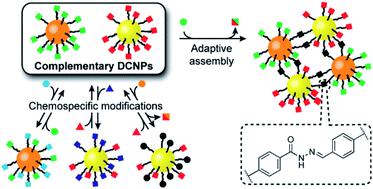当前位置:
X-MOL 学术
›
Chem. Sci.
›
论文详情
Our official English website, www.x-mol.net, welcomes your
feedback! (Note: you will need to create a separate account there.)
Programmable dynamic covalent nanoparticle building blocks with complementary reactivity
Chemical Science ( IF 7.6 ) Pub Date : 2019-11-14 , DOI: 10.1039/c9sc04195h Nicolas Marro 1, 2, 3, 4 , Flavio della Sala 1, 2, 3, 4 , Euan R. Kay 1, 2, 3, 4
Chemical Science ( IF 7.6 ) Pub Date : 2019-11-14 , DOI: 10.1039/c9sc04195h Nicolas Marro 1, 2, 3, 4 , Flavio della Sala 1, 2, 3, 4 , Euan R. Kay 1, 2, 3, 4
Affiliation

|
Nanoparticle-based devices, materials and technologies will demand a new era of synthetic chemistry where predictive principles familiar in the molecular regime are extended to nanoscale building blocks. Typical covalent strategies for modifying nanoparticle-bound species rely on kinetically controlled reactions optimised for efficiency but with limited capacity for selective and divergent access to a range of product constitutions. In this work, monolayer-stabilized nanoparticles displaying complementary dynamic covalent hydrazone exchange reactivity undergo distinct chemospecific transformations by selecting appropriate combinations of ‘nucleophilic’ or ‘electrophilic’ nanoparticle-bound monolayers with nucleophilic or electrophilic molecular modifiers. Thermodynamically governed reactions allow modulation of product compositions, spanning mixed-ligand monolayers to exhaustive exchange. High-density nanoparticle-stabilizing monolayers facilitate in situ reaction monitoring by quantitative 19F NMR spectroscopy. Kinetic analysis reveals that hydrazone exchange rates are moderately diminished by surface confinement, and that the magnitude of this effect is dependent on mechanistic details: surface-bound electrophiles react intrinsically faster, but are more significantly affected by surface immobilization than nucleophiles. Complementary nanoparticles react with each other to form robust covalently connected binary aggregates. Endowed with the adaptive characteristics of the dynamic covalent linking process, the nanoscale assemblies can be tuned from extended aggregates to colloidally stable clusters of equilibrium sizes that depend on the concentration of a monofunctional capping agent. Just two ‘dynamic covalent nanoparticles’ with complementary thermodynamically governed reactivities therefore institute a programmable toolkit offering flexible control over nanoparticle surface functionalization, and construction of adaptive assemblies that selectively combine several nanoscale building blocks.
中文翻译:

具有互补反应性的可编程动态共价纳米粒子构建基块
基于纳米粒子的设备,材料和技术将要求合成化学的新时代,其中分子机制中熟悉的预测原理将扩展到纳米级构建基块。修饰与纳米粒子结合的物质的典型共价策略依赖于为效率优化的动力学控制反应,但对多种产品成分的选择性和发散能力有限。在这项工作中,通过选择“亲核”或“亲电”纳米粒子结合的单分子层与亲核或亲电分子修饰剂的适当组合,表现出互补动态共价交换反应性的单层稳定纳米粒子会经历独特的化学特异性转化。热力学控制的反应可调节产物组成,跨越混合配体单分子层进行彻底交换。高密度纳米颗粒稳定单层促进定量监测原位反应19F NMR光谱。动力学分析表明,surface的交换速率通过表面限制而适度降低,并且这种作用的程度取决于机理的细节:表面结合的亲电试剂本质上反应更快,但比亲核试剂受表面固定化的影响更大。互补的纳米粒子相互反应,形成牢固的共价连接的二元聚集体。具有动态共价连接过程的适应性特征,可以将纳米级组件从扩展的聚集体调整到平衡大小取决于单官能封端剂浓度的胶体稳定簇。
更新日期:2019-11-14
中文翻译:

具有互补反应性的可编程动态共价纳米粒子构建基块
基于纳米粒子的设备,材料和技术将要求合成化学的新时代,其中分子机制中熟悉的预测原理将扩展到纳米级构建基块。修饰与纳米粒子结合的物质的典型共价策略依赖于为效率优化的动力学控制反应,但对多种产品成分的选择性和发散能力有限。在这项工作中,通过选择“亲核”或“亲电”纳米粒子结合的单分子层与亲核或亲电分子修饰剂的适当组合,表现出互补动态共价交换反应性的单层稳定纳米粒子会经历独特的化学特异性转化。热力学控制的反应可调节产物组成,跨越混合配体单分子层进行彻底交换。高密度纳米颗粒稳定单层促进定量监测原位反应19F NMR光谱。动力学分析表明,surface的交换速率通过表面限制而适度降低,并且这种作用的程度取决于机理的细节:表面结合的亲电试剂本质上反应更快,但比亲核试剂受表面固定化的影响更大。互补的纳米粒子相互反应,形成牢固的共价连接的二元聚集体。具有动态共价连接过程的适应性特征,可以将纳米级组件从扩展的聚集体调整到平衡大小取决于单官能封端剂浓度的胶体稳定簇。











































 京公网安备 11010802027423号
京公网安备 11010802027423号